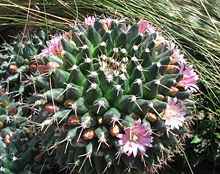- Phyllotaxis
-
In botany, phyllotaxis or phyllotaxy is the arrangement of leaves on a plant stem (from Ancient Greek phýllon "leaf" and táxis "arrangement").[1]
Contents
Pattern structure
The basic patterns are opposite, or alternate = spiral, Leaves may also be whorled if several leaves do, or appear to arise from the same level on a stem.
With an opposite leaf arrangement, two leaves arise from the stem at the same level (at the same node), on opposite sides of the stem. An opposite leaf pair can be thought of as a whorl of two leaves.
With an alternate (spiral) pattern, each leaf arises at at different point (node) on the stem.
Distichous phyllotaxis, also called "two-ranked leaf arrangement" is a special case of either opposite or alternate leaf arrangement where the leaves on a stem are arranged in two vertical columns on opposite sides of the stem.
 Distichous leaf arrangement in Clivia
Distichous leaf arrangement in Clivia
In an opposite pattern, if successive leaf pairs are perpendicular, this is called decussate.
A whorl can occur as a basal structure where all the leaves are attached at the base of the shoot and the internodes are small or nonexistent. A basal whorl with a large number of leaves spread out in a circle is called a rosette.
Repeating spiral
A repeating spiral can be represented by a fraction describing the angle of windings leaf per leaf.
Alternate leaves will have an angle of ½ of a full rotation. In beech and hazel the angle is ⅓, in oak and apricot it is ⅖, in poplar and pear it is ⅜, and in willow and almond the angle is 5/13.[2] The numerator and denominator normally consist of a Fibonacci number and its second successor. The number of leaves is sometimes called rank, in the case of simple Fibonacci ratios, because the leaves line up in vertical rows. With larger Fibonacci pairs, the pattern becomes complex and non-repeating. This tends to occur with a basal configuration. Examples can be found in composite flowers and seed heads. The most famous example is the sunflower head. This phyllotactic pattern creates an optical effect of criss-crossing spirals. In the botanical literature, these designs are described by the number of counter-clockwise spirals and the number of clockwise spirals. These also turn out to be Fibonacci numbers. In some cases, the numbers appear to be multiples of Fibonacci numbers because the spirals consist of whorls.
Leonardo da Vinci was the first to suggest that the adaptive advantage of the Fibonacci pattern is to maximize exposure to dew. Current thinking supports this interpretation.[citation needed] Phyllotactic architecture optimizes access to moisture, rainfall and sunlight.
Determination
The pattern of leaves on a plant is ultimately controlled by the local depletion of the plant hormone auxin in certain areas of the meristem.[3] Leaves become initiated in localized areas where auxin is absent. When a leaf is initiated and begins development, auxin begins to flow towards it, thus depleting auxin from another area on the meristem where a new leaf is to be initiated. This gives rise to a self-propagating system that is ultimately controlled by the ebb and flow of auxin in different regions of the meristematic topography.[4]
History
Insight into the mechanism had to wait until Wilhelm Hofmeister proposed a model in 1868. The process begins with two primordia, nascent leaves, forming on opposite sides of the shoot. A third new leaf then erupts between them. Each old leaf pushes the upstart away. The golden angle is the blind result of this jostling. Since three golden arcs add up to slightly more than enough to wrap a circle, one of the old leaves overlaps and is pushed out in a radial line, like a rocket that escapes earth orbit. This vacates space in the inner generative spiral for a new leaf to form. The generative spiral should not be confused with the clockwise and counter-clockwise spirals that emerge in densely packed plant structures. Spirals are discerned by tracing the path from leaf to neighboring leaf and each leaf acquires new neighbors as it shoots out from the center and its sister primordia. New leaves move into the spaces opened as old leaves diverge. Phi is an irrational number and this guarantees that no two leaves ever follow the same radial line from center to edge.
In modern times, researchers such as Snow and Snow[citation needed] have continued these lines of inquiry. Computer modeling and morphological studies have confirmed and refined Hoffmeister's ideas. Questions remain about the details. Botanists are divided on whether the control of leaf migration depends on chemical gradients among the primordia or purely mechanical forces. Lucas rather than Fibonacci numbers have been observed in a few plants and occasionally the leaf positioning appears to be random.
Phyllotaxis and physics
Physical models of phyllotaxis date back to Airy's experiment of packing hard spheres. Douady et al. also have shown experimentally and theoretically that phyllotactic patterns emerge as self-organizing processes in dynamic systems.[5] In 1991, Levitov proposed that lowest energy configurations of repulsive particles in cylindrical geometries reproduce the spirals of botanical phyllotaxis.[6] More recently (2009), Nisoli, Gabor et al. have shown experimentally and numerically that indeed that was the case, by constructing a "magnetic cactus" made of magnetic dipoles mounted on bearings stacked along a "stem".[7][8] They also revealed that these interacting particles can access novel dynamical phenomena beyond what botany yields: a family of highly non local novel topological solitons emerge in the nonlinear regime of these systems, as well as purely classical rotons and maxons in the spectrum of linear excitations. They named these novel phenomena "Dynamical Phyllotaxis", as they appear in physical systems whose statics is dictated by the number theoretical laws of phyllotaxis. Close packing of spheres also generates a dodecahedral tesselation with pentaprismic faces. Pentaprismic symmetry is intimately related to the Fibonacci series and the golden section of classical geometry. This relationship has been explored at length by Matila Ghyka.[9]
See also
- Fermat's spiral
- L-system
- Plastochron
Notes
- ^ φύλλον, τάξις. Liddell, Henry George; Scott, Robert; A Greek–English Lexicon at Perseus Project
- ^ Coxeter, H. S. M. (1961). Introduction to geometry. Wiley. pp. 169.
- ^ Traas J, Vernoux T (June 2002). "The shoot apical meristem: the dynamics of a stable structure". Philos. Trans. R. Soc. Lond., B, Biol. Sci. 357 (1422): 737–47. doi:10.1098/rstb.2002.1091. PMC 1692983. PMID 12079669. http://rstb.royalsocietypublishing.org/cgi/pmidlookup?view=long&pmid=12079669.
- ^ Smith, RS (2008). "The role of Auxin Transport in Plant Patterning Mechanisms". PLoS Biol. Trans. R. Soc. Lond., B, Biol. Sci. 6 (12): e323. doi:10.1371/journal.pbio.0060323. PMC 2602727. PMID 19090623. http://www.plosbiology.org/article/info:doi%2F10.1371%2Fjournal.pbio.0060323%3B.
- ^ Douady S, Couder Y (March 1992). "Phyllotaxis as a physical self-organized growth process". Phys. Rev. Lett. 68 (13): 2098–2101. Bibcode 1992PhRvL..68.2098D. doi:10.1103/PhysRevLett.68.2098. PMID 10045303. http://link.aps.org/abstract/PRL/v68/p2098.
- ^ Levitov LS (15 March 1991). "Energetic Approach to Phyllotaxis". Europhys. Lett. 14 (6): 533–9. doi:10.1209/0295-5075/14/6/006. http://www.iop.org/EJ/article/0295-5075/14/6/006/epl_14_6_006.pdf.
Levitov LS (January 1991). "Phyllotaxis of flux lattices in layered superconductors". Phys. Rev. Lett. 66 (2): 224–7. Bibcode 1991PhRvL..66..224L. doi:10.1103/PhysRevLett.66.224. PMID 10043542. http://link.aps.org/abstract/PRL/v66/p224. - ^ Nisoli C, Gabor NM, Lammert PE, Maynard JD, Crespi VH (May 2009). "Static and dynamical phyllotaxis in a magnetic cactus". Phys. Rev. Lett. 102 (18): 186103. arXiv:cond-mat/0702335. Bibcode 2009PhRvL.102r6103N. doi:10.1103/PhysRevLett.102.186103. PMID 19518890. http://link.aps.org/abstract/PRL/v102/p186103.
- ^ Nisoli C, (August 2009). "Spiraling solitons: A continuum model for dynamical phyllotaxis of physical systems". Phys. Rev. E 80 (2): 026110. arXiv:0907.2576. doi:10.1103/PhysRevE.80.026110. http://scitation.aip.org/getabs/servlet/GetabsServlet?prog=normal&id=PLEEE8000080000002026110000001&idtype=cvips&gifs=yes.
- ^ Matila Ghyka. The Geometry of Art and Life. Dover. ISBN 0486235424. http://store.doverpublications.com/0486235424.html.
References
- F.M.J. van der Linden
- van der Linden FMJ (1 April 1996). "Creating phyllotaxis: The stack-and-drag model". Mathematical Biosciences 133 (1): 21–50. doi:10.1016/0025-5564(95)00077-1. PMID 8868571.
- Frank M.J. van der Linden (1998). "Creating Phyllotaxis from Seed to Flower". In Denis Barabe; Jean, Roger V.. Symmetry in Plants. World Scientific Series in Mathematical Biology and Medicine. 4. Singapore: World Scientific Pub Co Inc. ISBN 981-02-2621-7.
External links
- Fibonacci Numbers and the Golden Section
- Phyllotaxis as a Dynamical Self Organizing Process
- Weisstein, Eric W., "Phyllotaxis" from MathWorld.
- Phyllotaxis Spirals and Phyllotaxis Spirals in 3D by Stephen Wolfram, The Wolfram Demonstrations Project.
- An interactive L-system using JSXgraph
- Phyllotaxis: An Interactive Site for the Study of Plant Pattern Formation
- PhaseLab
- Magnetic Cactus Experimentally Demonstrates Mathematical Plant Patterns
Categories:- Plant morphology
- Leaves
Wikimedia Foundation. 2010.










